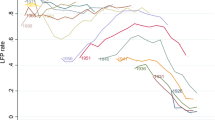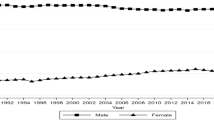Abstract
This study investigates the increase in the labour force participation rate of women. We estimate a binary age–period–cohort model for a sample of Dutch women born between 1925 and 1986. The results indicate that the increasing level of education and the diminishing negative effect of children have played an important role. Moreover, we find important unobserved cohort effects for pre-1955 generations, which is in line with results of studies on social norms. It is shown that the growth in female participation is likely to slow down in the near future, as such cohort effects are not relevant for younger generations.
Similar content being viewed by others
References
Aaberge R, Colombino U, Holmøy E (2004) Population ageing and fiscal sustainability: an integrated micro-macro analysis of required tax changes. Discussion Paper 367, Statistics Norway
Akerlof G (1980) A theory of social custom, of which unemployment may be one consequence. Q J Econ 94: 749–775
Apps P (1991) Tax reform, population ageing and the changing labour supply behaviour of married women. J Popul Econ 4: 201–216
Attanasio O, Low H, Sanchez-Marcos V (2008) Explaining changes in female labour supply in a life-cycle model. Am Econ Rev 98(4): 1517–1552
Benati L (2001) Some empirical evidence of the discouraged worker effect. Econ Lett 70: 387–395
Blundell R, MaCurdy T (1999) Labour supply: a review of alternative approaches. In: Ashenfelter O, Card D (eds) Handbook of labor economics, vol 3A. North-Holland, Amsterdam, pp 1559–1695
Coleman M, Pencavel J (1993) Trends in market work behavior of women since 1940. Ind Labor Relat Rev 46: 653–676
Colombino U, De Stavola B (1985) A model of female labor supply in Italy using cohort data. J Labor Econ 3: S275–S292
Cörvers F, Golsteyn B (2003) Changes in women’s willingness to work in a tightening labour market: the impact of preferences, wages and individual characteristics. ROA Research Memorandum 2003/5E
Cournède B, Gonand F (2006) Restoring fiscal sustainability in the Euro Area: raise taxes or curb spending? Economics Department Working Paper No. 520, OECD
CPB (2006) Het groeipotentieel van de Nederlandse economie tot 2011. CPB Document 117
Darby J, Hart R, Vecchi M (2001) Labour force participation and the business cycle: a comparative analysis of France, Japan, Sweden, and the United States. Japan World Econ 13: 113–133
de Jong A (2005) Bevolkingsprognose 2004–2050: maximaal 17 miljoen inwoners. Bevolkingstrends 53(1): 12–18
Euwals R, van Vuuren D, den Ouden A, Rijn J (2006) Arbeidsaanbod naar sociaaldemografische kenmerken. CPB Memorandum 171
Fernandez R (2007) Culture as learning: the evolution of female labour force participation over a century. CEPR Discussion Paper 6451
Fernandez R, Fogli A, Olivetti C (2004) Preference formation and the rise of women’s labour force participation: evidence from WWII. NBER Working Paper 10589
Fitzenberger B, Schnabel R, Wunderlich G (2004) The gender gap in labor market participation and employment: a cohort analysis for West Germany. J Popul Econ 17(1): 83–116
Fitzenberger B, Wunderlich G (2004) The changing life cycle pattern in female employment: a comparison of Germany and the UK. Scott J Polit Econ 51: 302–328
Fogli A, Veldkamp L (2007) Nature or nurture? Learning and female labour force dynamics. CEPR Discussion Paper 6324
Goldin C (2004) The long road to the fast track: career and family. Ann Am Acad Pol Soc Sci 596: 20–35
Goldin C (2006) The ‘quiet revolution’ that transformed women’s employment, education, and family. Am Econ Rev Papers Proc 96: 1–21
Goldin C, Katz L (2002) The power of the pill: oral contraceptives and women’s career and marriage decisions. J Polit Econ 10: 730–770
Gregg P (1994) Out for the count: a social scientist’s analysis of unemployment statistics in the UK. J R Stat Soc Ser A 157: 253–270
Groot W, Pott-Buter H (1993) Why married women’s labor supply in the Netherlands has increased?. De Economist 141: 238–255
Hall R (1971) The measurement of quality change from vintage price data. In: Griliches Z (eds) Price indexes and quality change, chapter 8. Harvard University Press, Cambridge, pp 240–271
Hartog J, Theeuwes J (1985) The emergence of the working wife in Holland. J Labor Econ 3: S235–S255
Henkens K, Grift Y, Siegers J (2002) Changes in female labour supply in the Netherlands 1989–1998: the case of married and cohabiting women. Eur J Popul 18: 39–57
Hurd M (1990) The joint retirement decision of husbands and wives. In: Wise D (eds) Issues in the economics of aging. The University of Chicago Press, Chicago, pp 231–254
Jongen E (2010) Child care subsidies revisited. CPB Document 200
Joshi H, Layard R, Owen S (1985) Why are more women working in Britain. J Labor Econ 3: S147–S175
Kapteyn A, Alessie R, Lusardi A (2005) Explaining the wealth holdings of different cohorts: productivity growth and social security. Eur Econ Rev 49: 1361–1391
Kremer M (2005) How welfare states care: culture, gender and citizenship in Europe., PhD thesis, Utrecht University
Layard R, Barton M, Zabalza A (1980) Married women’s participation and hours. Economica 47: 51–72
Maloney T (1991) Unobserved variables and the elusive added worker effect. Economica 58: 173–187
Maloney T (1997) Employment constraints and the labor supply of married women: a reexamination of the added worker effect. J Hum Resour 22: 51–61
Mason K, Mason W, Winsborough H, Poole W (1973) Some methodological issues in cohort analysis of archival data. Am Sociol Rev 38: 242–258
Nakamura A, Nakamura M (1994) Predicting female labor supply: effects of children and recent work experience. J Hum Resour 29: 304–327
Pencavel J (1998) The market work behavior and wages of women: 1975–1994. J Hum Resour 33: 771–804
Pfau-Effinger B (1993) Modernisation, culture and part-time employment: the example of Finland and Germany. Work Soc Employ 7: 383–410
Prieto-Rodriguez J, Podriguez-Gutierrez C (2000) The added worker effect in the Spanish case. Appl Econ 31: 1917–1925
Roeger W (2002) ‘Ageing and pensions in Europe’, mimeo, European Commission, Directorate General for Economic And Financial Affairs
Rother P, Catenaro M, Schwab G (2002) ‘Ageing and pensions in the Euro area; survey and projection results’, mimeo, European Central Bank
Schirle T (2008) Why have the labor participation rates of older men increased since the mid-1990s?. J Labor Econ 26(4): 549–594
SCP/CBS (2006) Emancipatiemonitor 2006. SCP publication 2006/22
Smith J, Ward M (1985) Time-series growth in the female labor force. J Labor Econ 3: S59–S90
Stephens M (2002) Worker displacement and the added worker effect. J Labor Econ 20(3): 504–537
Sundström M (1991) Part-time work in Sweden: trends and equality effects. J Econ Issues 25: 167–187
Tachibanaki T, Sakurai K (1991) Labour supply and unemployment in Japan. Eur Econ Rev 35: 1575–1587
van Agtmaal-Wobma E, van Duin C (2007) Huishoudensprognose 2006-2050: belangrijkste uitkomsten. Bevolkingstrends 55(2): 53–59
van Ewijk C, Draper D, ter Rele H, Westerhout E (2006) Ageing and the sustainability of Dutch public finances. CPB Netherlands Bureau for Economic Policy Analysis
Vendrik M (2001) Dynamics of a household norm in female labour supply. J Econ Dyn Control 27: 823–841
Author information
Authors and Affiliations
Corresponding author
Rights and permissions
About this article
Cite this article
Euwals, R., Knoef, M. & van Vuuren, D. The trend in female labour force participation: what can be expected for the future?. Empir Econ 40, 729–753 (2011). https://doi.org/10.1007/s00181-010-0364-9
Received:
Accepted:
Published:
Issue Date:
DOI: https://doi.org/10.1007/s00181-010-0364-9




